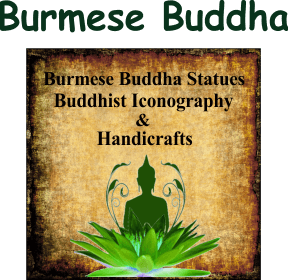Buddhist Deity Hayagriva Avatar of Vishnu
The Buddhist Deity Hayagriva Avatar of Vishnu is depicted in murals in the temples of Pagan and Mrauk-U. Buddhist iconography excavated in Burma in the form of bronze castings of the Buddha, and deities generally associated with Hinduism were influenced through their interactions with visiting Hindu and Buddhist pilgrims during the first Millennium.
The central figure on this rare round bronze disc is a depiction of the Hayagriva, with a horse head and a human body. The Hayagriva Hindu Deity is regarded as the “God of knowledge and wisdom”, and one of the Avatars of Vishnu, primarily worshipped by the Vaishnavas and believed to be one of the incarnations of the Buddha. Vishnu is one of the most highly worshipped deities in India. Haya means horse and Griva means neck in Sanskrit. According to myth and legend, the Hayagriva’s incarnation took place to restore the Vedas to Lord Brahma and to restore cosmic order.
It is believed that there are one hundred and eight depictions of the Hayagriva, this deity is worshipped in parts of South East Asia where there is a strong Hindu following. Hayagriva is often represented with several arms, holding a conch shell or sword, sometimes with Lakshmi his consort seated on his knee, usually seated on a lotus flower.
Excerpt from the Book “The Mists of Ramanna“, an excellent historical account of the Mon, Pyu, and Pagan kingdoms and their early relationship with India – written By Michael A. Aung-Thwin
 Pyü iconography also revealed evidence of tantric and other forms of Mahäyäna Buddhism. Avalokitesvara, Tärä, Mänusi, Jambhala, Lokanätha, and Hayagrïva, all prominent in Mahayana Buddhism, were very much part of the Pyü, and later the Pagán scene. Brahmanism was also well represented in iconography at SrïKsetra. The standing figures of Vishnu and his consort, Lakshmï, are found together in bold relief on a sandstone slab. Other manifestations of Vishnu were found, one with four arms, standing on his vehicle, Garuda, while another has him reclining on the serpent Ananta, a motif also found at Nat-Hlaung-Gyaung temple in Bagan (old name Pagan) dating to the 11th century shows three lotus flowers that emerge from the navel of the reclining Visnu, members of the Hindu Trinity: Brahmä, Vishnu, and Shiva. The Nat-Hlaung-Gyaung is the only existing Hindu temple in Bagan.
Pyü iconography also revealed evidence of tantric and other forms of Mahäyäna Buddhism. Avalokitesvara, Tärä, Mänusi, Jambhala, Lokanätha, and Hayagrïva, all prominent in Mahayana Buddhism, were very much part of the Pyü, and later the Pagán scene. Brahmanism was also well represented in iconography at SrïKsetra. The standing figures of Vishnu and his consort, Lakshmï, are found together in bold relief on a sandstone slab. Other manifestations of Vishnu were found, one with four arms, standing on his vehicle, Garuda, while another has him reclining on the serpent Ananta, a motif also found at Nat-Hlaung-Gyaung temple in Bagan (old name Pagan) dating to the 11th century shows three lotus flowers that emerge from the navel of the reclining Visnu, members of the Hindu Trinity: Brahmä, Vishnu, and Shiva. The Nat-Hlaung-Gyaung is the only existing Hindu temple in Bagan.
Pyu Bronze Disc with Hayagriva Deity
The largest and most important Pyu city was Sri Ksetra, which became the capital of the Pyu realm in the 7th or 8th century. The Pyu culture was influenced by Indian civilization, especially in the fields of religion, art, literature, and architecture. The Pyu cities had administrative compounds, palaces, temples, monasteries, stupas, and irrigation systems. Hayagriva was one of the deities that adorned the Pyu temples and stupas, along with Avalokitesvara, Tara, Manusi Buddhas, and Vaisravana. Hayagriva represented the triumph of pure knowledge over ignorance and darkness.
This mystery bronze disc has intrigued us for many years and is still a source of intrigue. We originally thought the bird on the top of the disc to be that of a peacock, but have concluded that the legs are possibly too thick, and the head with the protrusion possibly rules out the peacock theory, whereas the hamsa or hintha bird is usually shown with thick legs and feet with a protrusion on the head. The hamsa bird is also seen in Indian art, and sculptures and is mentioned in ancient literature.
Hamsa, a Sanskrit word, translates into hintha, the Burmese version of the Hamsa bird. Although the real hamsa bird is a graceful swan-like bird it can also fly. According to Mon legends, the ancient city of Hamsawaddy now referred to as Bago, located 91 kilometres north-east of Yangon was founded nearly 2000 years ago.
The hamsa or hintha bird, peacock, and naga are significant symbolic creatures in Burma, especially to the Mon people of Burma. The current Mon flag features a Hamsa bird. The hamsa bird is also seen in Tibetan, Indian, and Cambodian Buddhist art and iconography. Stories, myths, and legends surrounding the Hamsa bird are bountiful, each with its own connotations and meanings. To learn more about Hayagriva in Buddhism
This disc was sourced in Myanmar we strongly believe it to be of Pyu origins but not ruling out Mon. The Mons from the early part of the first millennium were worshipers of Vishnu as well as Buddhism.

